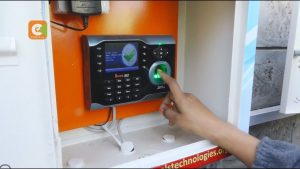Whenever a new technology appears, we immediately notice its effect on education. From the invention of smartphones and app development to AR and VR, we saw how these innovations made their contribution to improving and modernizing education.
The same can be said about biometrics.
The education sector started feeling the impact of biometrics back in 2014. Back then, it was reported that its impact would increase by almost 24% by 2019.
Now, it’s 2020. Have we noticed any changes brought by biometrics to education?
Definitely.
Let’s take a look at a few examples, how biometric data can be used to enhance learning.
1. Improving Student Safety
Back in 2017, Veevo Tech posted their video describing Educational Notifier – the technology that replaces school diaries and other obsolete methods to pass notifications from teachers to students and their parents.
Among many features of this tool, the video described its ability to send in/out safety notifications. These notifications are sent to parents once their child has arrived at school.
How does it work?
Students scan their fingers with a device that records their biometric data and, after verifying it, sends a notification to the parents, informing them that their child is at school.
A similar device was tested in Kenya one year ago after several students went missing while presumably being at school.
Apart from sending parents a notification, when their children arrived at school, the biometric verification system was also used to send messages, when children left school for co-curricular activities.
Teachers also have to sign in using biometric verification to help school security keep track of who enters and leaves the school at all times.
Better learning starts with safe schools. In this, biometrics can help school administrators improve security systems at schools so that both teachers and students could feel comfortable and safe in the classroom environment.
2. Measuring Students’ Productivity
Student engagement in the classroom is important for their academic performance. How do teachers usually measure it? Subjectively, and often it is impossible to track everyone’s performance, especially if you have over 20 students in front of you.
Here’s where biometric data comes to assist educators with measuring productivity. Here’s an example of how it has already been used.
China is known for its widespread facial recognition technology. “The use of facial recognition in China in different industries has increased by more than 40%,” reports Lindsey Graham, a market researcher at SupremeDissertations.
You may have heard about facial recognition and other biometric data being used to ensure safety on the streets and track the movement of citizens. And, Chinese education is no exception.
Last year, the Wall Street Journal made a reportage on the application of biometrics to measure productivity in students during class.
The devices detect the movement on students’ faces to identify the level of their engagement – red for deep focus, and blue for being distracted. This way, teachers can objectively measure how well students are engaged during the lesson, as they get a report on their tablet, which updates during the class.
The same reports are sent to the parents of the students to notify them about how well students work during the class.
Chinese educators believe that this biometric technology can help boost academic performance and interest in learning, as teachers can track their productivity and engagement at all times during the class.
3. Making Time at the Library More Productive
Similar to increasing productivity in students during class, biometrics can also help make the time that students spend in the library more productive as well.
Biometrics was introduced in school libraries a long time ago, first applications came from England. However, back then, it raised serious security concerns, and biometrics was temporarily banned in schools around the United Kingdom.
Today, however, we see the return of biometrics in school libraries. There, librarians collect biometric data from students to track book loans, as well as help students use devices inside the library, log into computers, where they can get access to online studying tools, like Studicus and WowGrade, as well as textbooks recommended by the teachers.
This application of biometrics brings quite a few benefits for libraries as well.
- Students are more motivated to use these facilities to study.
- Biometric data is easier and safer to store than library tickets.
- Biometrics makes it easier to track the library’s resources and keep track of books and other materials.
In addition to all the above-mentioned points, biometric data is very difficult to steal or copy, which adds points to student safety and security of their personal information.
There’s Still a Lot of Room for Improvement
While all the points that we mentioned paint the picture of biometrics being the game-changer in education, the reality is still quite far from being ideal.
Theodore Zanto, a neuroscientist from the Wall Street Journal reportage that we mentioned earlier, told that the use of biometrics in education is still under research, and there are still questions that raise concern.
One of these questions is the privacy of students’ data and doubts, whether it’s legal to collect their biometric data and use it for tracking. This was one of the reasons why the U.K. refused to use biometric data in the libraries as well as to collect payments at the school cafeteria.
This brings us to the point that, before implementing biometric technology to enhance learning, schools should have implement cybersecurity systems. While biometric data is hard to copy, there are still certain risks associated with data breaches and hacking.
Apart from that, biometric technology is still under development, so it will be a long time before the technology will be secure enough for schools to implement on a larger scale. And, in case the system fails, it will cost a school a lot of money.
Nevertheless, the current implementations of biometric technology in education are already showing promise, and there is a lot of potential for this technology to change education in the future.
About the Author:
Nicole Garrison is a professional Digital Marketing Specialist and Content Creator at writing services Best Essay Education and Grab My Essay. Her career goals are focused on bridging the gap between theory and practice in digital marketing to allow readers from across the world a cohesive and approachable way of enjoying online content. In her spare time, Nicole enjoys cycling through the city and cooking international dishes.






